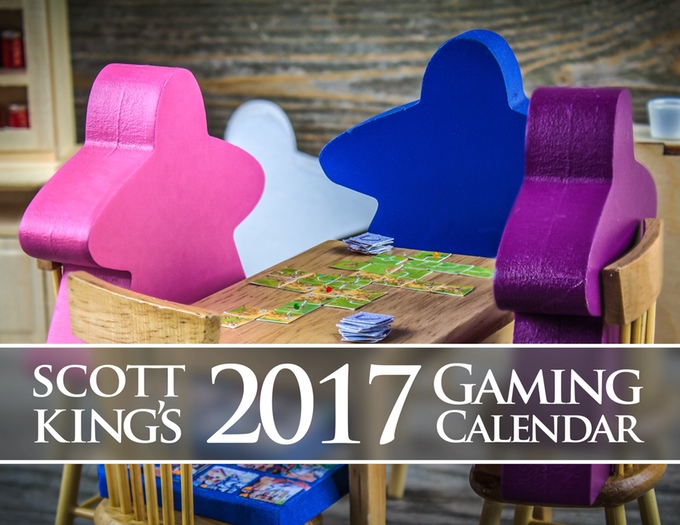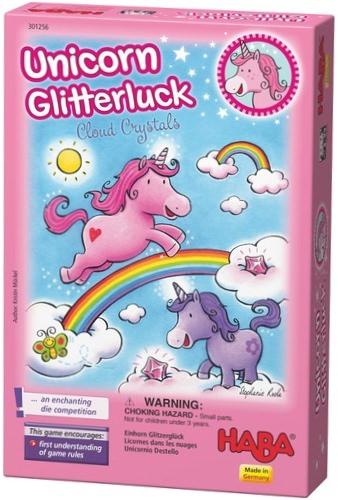Crazy Karts is chaotic kart racing!
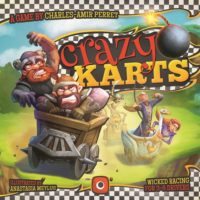
Mario Kart tournaments have been one of our fun Thanksgiving traditions we look forward to every year. We’ve enjoyed many extended family Thanksgiving weekends racing and battling with turtle shells and banana peels flying all over the place.
A couple years we even set up multiple game systems where losers would move down one TV and winners would move up. We had such a blast with cousins and uncles hooting and hollering race after race and battle after battle.
So when I heard that Crazy Karts from Portal Games was like Mario Kart in board game form, I could hardly contain my excitement. Now was our chance to battle it out on the table instead of the screen!
It may have taken a bit longer to get a copy than I had hoped. But I finally bought a copy of Crazy Karts at the Portal Games booth at Gen Con 2016.
And since the game can play up to 8 players, I wanted our first experience to be a full one – and a Guys Game Night was the perfect chance for it.
So now that we’ve taken Crazy Karts through its paces, the big question is – does it live up to my grand expectations?
Let’s see.
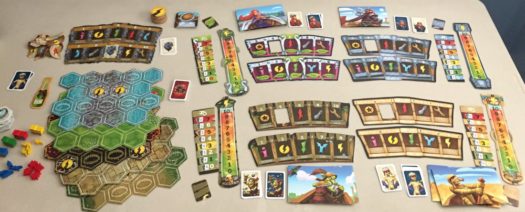
How to play Crazy Karts
Since it’s a race game, you can easily guess what the main goal of the game is…To win the race.
However, in Crazy Karts, players don’t win alone. In fact, they don’t race alone either.
In a game of Crazy Karts, players work in teams of 2 to be the first to cross the finish line. Sounds simple, right?
But there’s a catch.
Each player controls different functions of their team’s kart.
And there’s another catch too.
Each player doesn’t know what their teammate is doing and they can’t discuss their plans!
Yep, it’s definitely crazy.
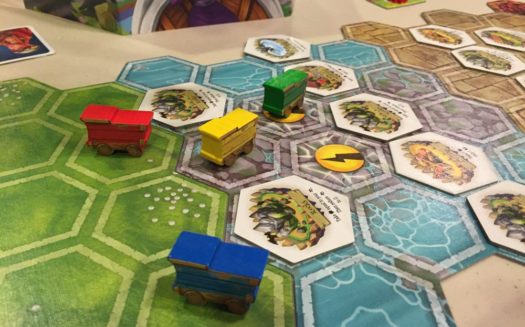
Set Up
A full game of Crazy Karts takes place over 2 races. The first race is a Qualifying Race and the second race we call The Real Race.
The first thing to do is set up the racetrack. For Qualifying it’s comprised of 3 board segments and for the real Race it’s made up of 4 segments. The first segment is always the green starting board and the other segments are chosen randomly from the remaining double-sided boards.
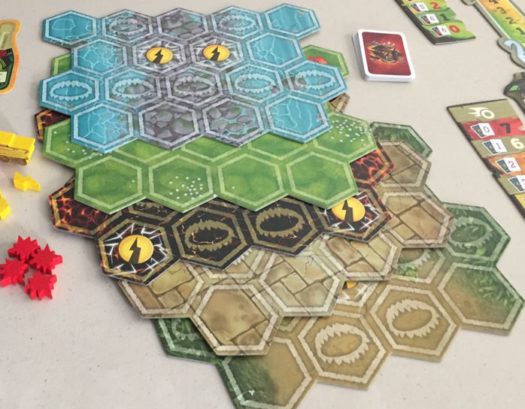
The boards have trap icons on some of their hex spaces. Players randomly place obstacle tiles onto every trap space on the track. The obstacles tiles are also double sided so players can either randomize which sides are up or they can be more selective.
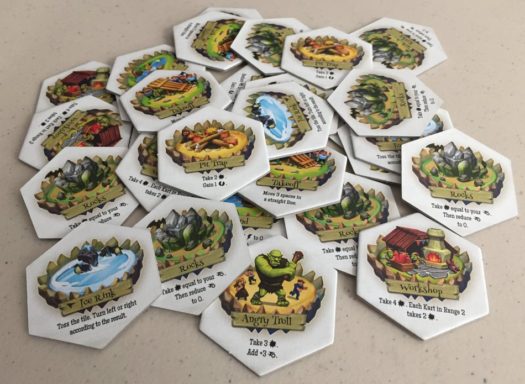
Players are divided into teams and select their Faction. Each player gets a deck of their faction cards, a control panel, and a player screen.
One player will have a control panel that controls the odd functions of the kart and the other player will have a control panel that controls the even functions. One player on each team will also get the Speedometer while their teammate gets the Power Up meter.
(After Qualifying, the teammates swap their control panels and meters.)
The teams place their Karts on the starting spaces of the track and are ready to race!
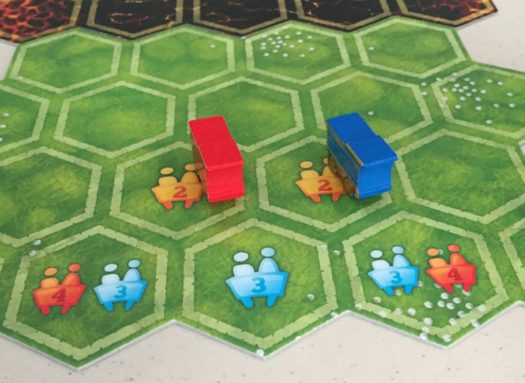
Racing
During Qualifying, the teams fight over pole position and upgrades for the real Race depending on how they finish. Otherwise, both races are played the same way.
Racing consists of 2 phases: Planning & Resolution
During the Planning stage, players simultaneously choose cards from their hand to play onto their Control Panel.
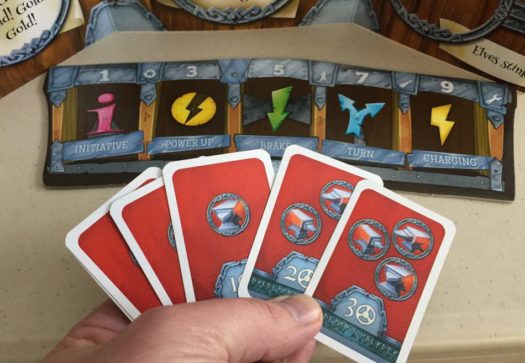
First players get back any cards on their control panel from the previous round. Then they shuffle their full deck of cards and draw cards into their hand. The number of cards they can draw depends on their Kart’s Speed. The faster their Kart is traveling, the less cards they’ll be able to draw.
For example, if their Kart is at Speed 4, each player on that team will only be able to draw 3 cards.
From their hand, players secretly place cards on their Control Panel face up. They can place as many cards as they’d like on any spaces/actions of their Control Panel.
Each card depicts a value of 1, 2, or 3. The combined value of cards placed on an action will be used during the Resolution phase.
Once a team has programmed their Kart, the rest of the teams have 5 seconds to complete their Planning. Thus, Planning should be done at a quick pace.
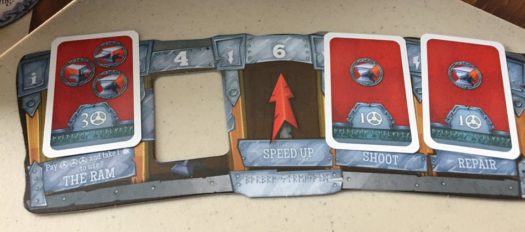
During the Resolution stage each action on the Control Panels is played out in turn, starting with #1 and proceeding through #10.
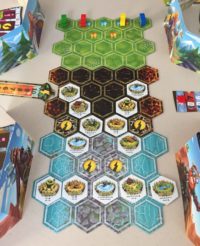
Here’s the rundown on each function of the Control Panels in the order they are played. (Remember that one player controls the odd numbered actions and their teammate controls the even numbered actions.)
- Initiative: The team with the highest value of cards played for Initiative will go first, followed by the other teams in descending order. If there’s a tie for any position in the order, the team with the Kart closest to the finish line goes first.
- Special Ability: Each Faction has a different Special Ability that they may choose to activate by playing the required value of cards on this action.
- Power Up Activation: If they’ve gained a Power Up token during an earlier round, they may play it along with the required value of cards on this action to use the Power Up ability. Only one token may be used each round and is discarded once used.
- Special Customization: This action is only used in the Advanced Game. There are 4 special tokens that can be randomly distributed to teams at the start of the game – which are placed on this action. As you’d expect, they grant a unique special ability to each team.
- Brake: The team reduces the Speed of their Kart by the value of the cards played on this action.
- Speed Up: The team increases the Speed of their Kart by the value of the cards played on this action.
After the Speed action is taken, the team then moves their Kart forward, in a straight line, a number of hexes equal to their Speed. If the Kart enters a space with an obstacle token, the Kart’s movement ends (unless otherwise noted on the token), the token is removed, and the effect is applied.
If the Kart moves into a space with a Power Up icon, the team draws the top Power Up token from the stack of Power Ups.
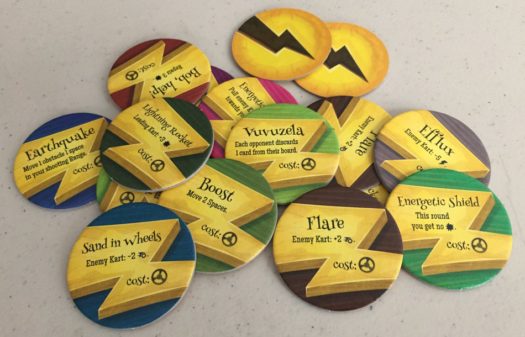
If the Kart hits the edge of the racetrack (Wall), it stops on the last hex before the wall and takes Damage equal to its Speed. Then the Speed is reset to 0.
If one Kart would move into a hex with another Kart, both Karts take 1 point of Damage and both Karts move 1 hex in the direction the moving Kart was going. If this extra hex move can’t happen because of a Wall, the hit Kart takes 1 extra Damage and reduces its Speed to 0.
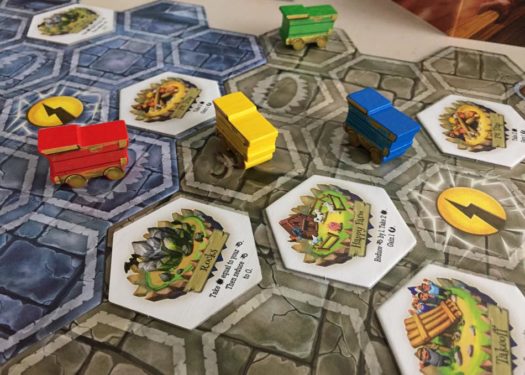
- Turn: To Turn, the value of cards played on this action must equal or exceed the Kart’s current Speed. If that is met, the team rotates the Kart on its current hex either left or right 1 hex side.
- Shoot: A Kart’s shooting range is equal to the value of cards played on this action. The team chooses an opponent’s Kart within range (in any direction) and the hit Kart’s team draws 1 Damage Card and resolves its effect. Shooting doesn’t have to be in a straight line and obstacles and other Karts don’t block shots.
- Charging: The team moves their Power Up marker up the number of spaces on their Power Up meter equal to the value of the cards played on this action. Once it reaches 10, the team draws the top Power Up token from the stack (to be used in later rounds), resets the Power Up marker at 0 and continues adding Power if the value of cards played had more to give.
- Repair: The team moves their Damage marker up on their Speedometer the number of spaces equal to the value of cards played on this action.
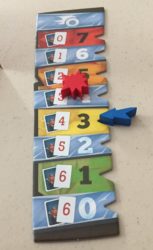
Damage Marker: Each time a Kart takes a point of Damage, the Damage tracker is moved down one space on the Speedometer.
The Damage tracker limits how fast a Kart can go. The Speed of a Kart can only go as high as the highest non-damaged space.
For example, if the Damage marker is on Speed 4, the highest Speed that Kart can go is 3.
In Qualifying, the order in which teams finish determines the number of random upgrades they receive and amount of Damage they can remove.
Game End
When a Kart crosses the finish line (end of the final board segment), players complete the round.
If another Kart crosses the finish line, they come in 2nd or 3rd, etc.
If only 1 Kart crosses the finish line, they’re the only winner!
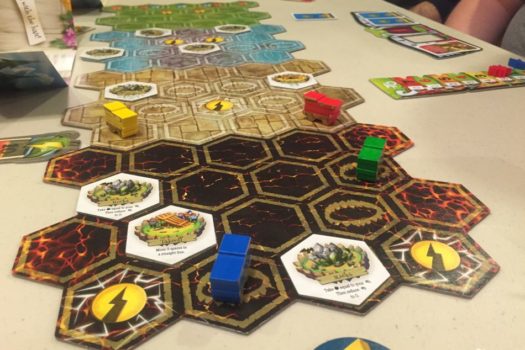
Can the whole family enjoy Crazy Karts?
With our Mario Kart tournaments, age didn’t matter. Everyone wanted a piece of the action no matter how old they were. And Crazy Karts isn’t much different.
The recommended age on the box says 8+ and that’s pretty accurate. Even though there’s plenty happening in the game, it isn’t too overwhelming and all flows nicely.
The cards that each player works with have both numbers and icons to designate their value. The Speedometer and Power Up meters are also both numerical. There’s text on the actions of the Control Panels, but they also include icons that are helpful in remembering what the action does.
So the only need for reading really comes down to the obstacle token, Power Up tokens, Damage Cards, and upgrades. But if a younger player can’t read, it’s not a problem because players are working on a team. Help is readily available from a teammate when it comes to understanding those tokens and cards.
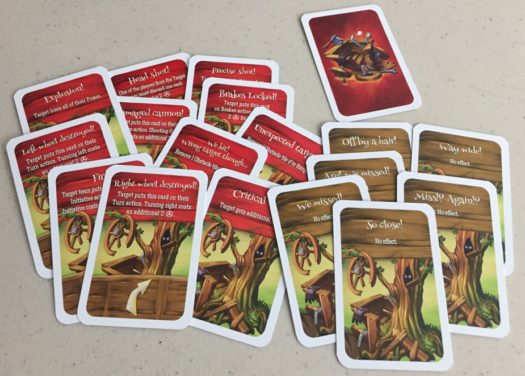
Is it really Mario Kart live?
We’ve played enough board games and video games to know it isn’t really fair to compare the stimulation between the two types of play. This holds true especially when it comes to racing games.
Racing video games have players on the edge of their seats because of how fast everything happens. They’re all about speedy reactions to real-time game play.
Racing board games on the other hand are all about tactical, planned play. They can’t compete 1-to-1 with the speed and visual bombardment of video game racing. But players do have to react to what happens on the track.
And Crazy Karts does a solid job at bringing a wacky race to board game form.
First of all is the visual appeal. We love the artwork of the characters and their related faction components – such as the shields and Control Panels. The art design on the tracks themselves is also terrific. Even though there’s not anything inherently different between the segments, each one provides a different layout of the obstacles and Power Up locations. And we love that they’re double-sided to add variety to the possible paths.
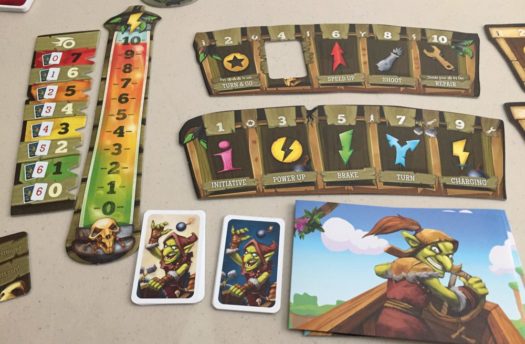
Sure we like playing strategic games that get us thinking. But we also love games with a healthy does of randomness and chaos. And Crazy Karts is definitely on the latter side.
The more Karts in the game, the more fun it is.
We’ve played with just 2 teams and it’s definitely not as fun as when there are 4 teams knocking each other around.
We love the gamble between speeding up and being in control. Going faster can get you farther. But it also comes with its own set of problems. First of all, going faster means each round you’ll draw less cards in your hand. So you’ll have fewer options to work with on your Control Panel. Second, going faster makes it harder to steer since turning requires card value equal to or higher than your speed.
So just going fast won’t win the race.
And of course, there’s the issue of other racers knocking you off your path. Not only will you take damage, but you’ll also have to deal with a change of plans.
But even with all of that, there’s still nothing quite like trying to control just half of your Kart!
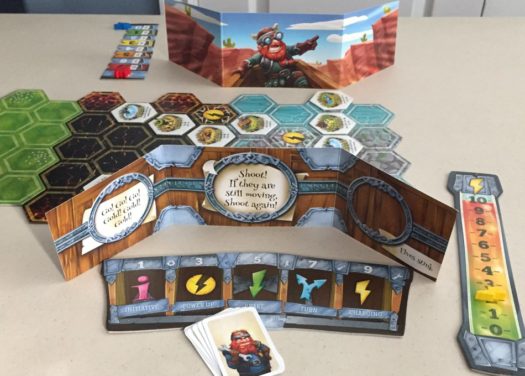
Sometimes we could care less about what the other teams are doing because we’re just worrying about what our own teammate is going to do with his half of the Kart.
That may sound maddening. But in the spirit of the game, it’s a hoot.
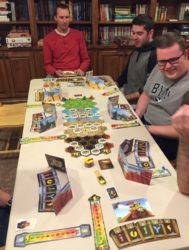
The one thing we would change is the length of the race. It takes long enough for us just to play through one race, that having a second race is very anti-climatic.
Rather than doing a Qualifying Race, we just set up the Real Race and randomly dish out upgrades at the start. We like the fun that upgrades provide, so we just get everyone in on that action.
Just make sure you have a big enough table for playing Crazy Karts. 8 players at a table can be pretty crowded when you also have to toss a racetrack in the center.
With a full 8 players, it can also be hard for the teams at the ends to easily see what’s going on in the race – as well as read the obstacle tokens so they know what they’re about to run into. Plan on there being players standing up to get a better look at their options during a race.
How does Crazy Karts score on our “Let’s Play Again” game meter?
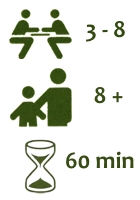 Crazy Karts is a fun and chaotic feeling game that’s great to pull out with 6 or 8 players. Yes, you can play with an odd number of players because there’s a “Lone Wolf” bot that can be used instead of a teammate. But the most fun is with 6 or 8 players.
Crazy Karts is a fun and chaotic feeling game that’s great to pull out with 6 or 8 players. Yes, you can play with an odd number of players because there’s a “Lone Wolf” bot that can be used instead of a teammate. But the most fun is with 6 or 8 players.
And with our oldest two children away from home now, we just don’t get 6 or 8 players together as often as we’d like. So our plays of Crazy Karts will be a bit limited.
The length of Crazy Karts also means it’s not a game we’ll play back-to-back. The standard game play already has 2 races in one game (including Qualifying) so it feels like back-to-back games. Yet, we still prefer to just do one race (just doing one race and adding 1 extra track segment than the rules prescribe is actually the perfect length of game).
If you’d like a bit of chaos in your next racing endeavor, then grab a copy of Crazy Karts!

